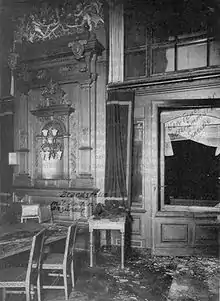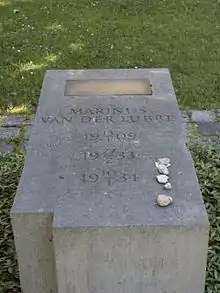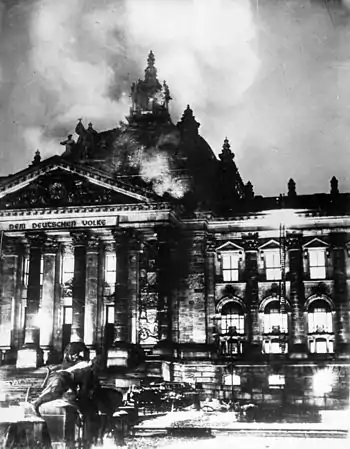Marinus van der Lubbe
Marinus van der Lubbe (13 January 1909 – 10 January 1934) was a Dutch communist who was tried, convicted and executed for setting fire to the German Reichstag building on 27 February 1933, an event known as the Reichstag fire. Nearly 75 years after the event, the German government granted van der Lubbe a posthumous pardon.[1]
Marinus van der Lubbe | |
|---|---|
 Marinus van der Lubbe | |
| Born | 13 January 1909 Leiden, South Holland, Netherlands |
| Died | 10 January 1934 (aged 24) |
Early life
Marinus van der Lubbe was born in Leiden in the province of South Holland. His parents were divorced, and after his mother died when he was twelve years old, he went to live with his half-sister's family. In his youth, van der Lubbe worked as a bricklayer. He was nicknamed Dempsey after boxer Jack Dempsey because of his great strength. While working, Van der Lubbe came in contact with the labour movement; in 1925, at age 16, he joined the Communist Party of the Netherlands (CPN) and its youth wing, the Communist Youth Bund (CJB).
In 1926, he was injured at work, getting lime in his eyes, which hospitalized him for a few months and almost left him blind. Since the injury forced him to quit his job, he was unemployed with a pension of only 7.44 guilders a week. After a few conflicts with his sister, Van der Lubbe moved to Leiden in 1927. There, he learned to speak some German and founded the Lenin House, where he organised political meetings. While working for the Tielmann factory, a strike broke out. Van der Lubbe claimed to the management to be one of the ringleaders and offered to accept any punishment if no one else was victimised, even though he was clearly too inexperienced to have been seriously involved. During the trial, he tried to claim sole responsibility and was purportedly hostile to the idea of getting off free.
Afterwards, Van der Lubbe planned to emigrate to the Soviet Union, but he lacked the funds to do so. He was politically active among the unemployed workers' movement until 1931, when he fell into disagreement with the CPN and instead approached the Group of International Communists. In 1933, Van der Lubbe fled to Germany to take action in the local communist underground. He had a criminal record for several attempted arsons.
Reichstag fire
Van der Lubbe claimed to have set the Reichstag building on fire in an attempt to rally German workers against fascist rule. He was brought to trial along with the head of the German Communist Party and three Bulgarian members of the Comintern. At his trial, van der Lubbe was convicted and sentenced to death for the Reichstag fire. The four other defendants (Ernst Torgler, Georgi Dimitrov, Blagoi Popov, and Vasil Tanev) were acquitted. Van der Lubbe was guillotined in a Leipzig prison yard on 10 January 1934, three days before his 25th birthday. He was buried in an unmarked grave on the Südfriedhof (South Cemetery) in Leipzig.
After World War II, moves were made by his brother, Jan van der Lubbe, in an attempt to overturn the original verdict. In 1967, his sentence was changed by a judge from death to eight years in prison. In 1980, after more lengthy complaints, a West German court overturned the verdict entirely, but that was criticised by the state prosecutor. The case was re-examined by the Federal Court of Justice of Germany for three years. In 1983, the court made a final decision on the matter and overturned the result of the 1980 trial on grounds that there was no basis for it and so it was illegal. However, on December 6, 2007, the Attorney General of Germany Monika Harms nullified the entire verdict and posthumously pardoned van der Lubbe, based on a 1998 German law that makes it possible to overturn certain cases of Nazi injustice. The court's determination was based on the premise that the National Socialist regime was, by definition, unjust, and since the case's death sentence had been politically motivated, it was likely to have contained an extension of that injustice. The conclusion was independent of the factual question of whether or not van der Lubbe had actually set the fire.[2][3][4]
Claimed responsibility


Historians disagree as to whether van der Lubbe acted alone, as he said, to protest the condition of the German working class, or was involved in a larger conspiracy. The Nazis blamed a communist conspiracy. Responsibility for the Reichstag fire remains an ongoing topic of debate and research in modern historical scholarship.[5][6][7] William Shirer, writing in The Rise and Fall of the Third Reich, surmised that van der Lubbe was goaded into setting a fire at the Reichstag but that the Nazis had set their own more elaborate fire at the same time. According to Ian Kershaw, writing in 1998, the consensus of nearly all historians is that van der Lubbe had in fact set the Reichstag on fire.[8]
In popular culture
- The Einstürzende Neubauten song "Feurio!" contains a reference to van der Lubbe: "Marinus du warst es nicht" (Marinus, it wasn't you).
- Dutch folk-rock band Janse Bagge Bend refers to van der Lubbe in their song "Kommer en Kwel".
- A The Fabulous Furry Freak Brothers story has one of the characters (Freewheelin' Franklin) referring to a fictitious "Marinus van der Lubbe International Firebombing Society".[9]
- W. H. Auden refers to van der Lubbe in his poem beginning "Easily, my dear, you move, easily your head", dated November 1934.
- Stephen Spender wrote a poem entitled Van der Lubbe.
- Belgian author Willem Elsschot wrote a poem entitled van der Lubbe.
Notes
- "75 years on, executed Reichstag arsonist finally wins pardon". the Guardian. 2008-01-12. Retrieved 2021-01-26.
- Announcement of the Attorney General of Germany (in German)
- "Marinus van der Lubbe gerehabiliteerd (Dutch)". Archived from the original on 2008-01-13. Retrieved 2008-01-10.
- Kate Connolly (January 12, 2008). "75 years on, executed Reichstag arsonist finally wins pardon". The Guardian.
- "The Reichstag Fire". Holocaust Encyclopedia. United States Holocaust Memorial Museum. Retrieved 12 August 2013.
- DW Staff (27 February 2008). "75 Years Ago, Reichstag Fire Sped Hitler's Power Grab". Deutsche Welle. Retrieved 12 August 2013.
- Anson Rabinbach, "Staging Antifascism: The Brown Book of the Reichstag Fire and Hitler Terror," in New German Critique, vol. 35, no. 1, (Spring 2008), pp. 97–126
- Kershaw, Ian Hitler Hubris pp. 456–458, 731–732
- "Straight Dope Message Board". boards.straightdope.com.
References
- Biography Marinus van der Lubbe on libcom.org history.
- Martin Schouten: Rinus van der Lubbe 1909–1934 – een biografie. De Bezige Bij, Amsterdam 1986.(in Dutch)
- Alexander Bahar and Wilfried Kugel: Der Reichstagbrand, edition q (2001) German language only.
- Hersch Fischler: Zum Zeitablauf der Reichstagsbrandstiftung. Korrekturen der Untersuchung Alfred Berndts, in: Vierteljahrshefte für Zeitgeschichte 55 (2005), S. 617–632.(with English summary)
- Anson Rabinbach, "Staging Antifascism: The Brown Book of the Reichstag Fire and Hitler Terror," in New German Critique, vol. 35, no. 1, (Spring 2008), pp. 97–126
External links
 Media related to Marinus van der Lubbe at Wikimedia Commons
Media related to Marinus van der Lubbe at Wikimedia Commons- English translation of The Reichstag Fire (1963) by Fritz Tobias, with introduction by A. J. P. Taylor
- Dutch Council Communism and Van der Lubbe Burning the Reichstag – The question of "exemplary acts" – the political repercussions of his act on his comrades.
- Zuidenwind Filmproductions at www.zuidenwind.nl Documentary about Marinus van der Lubbe
- Marinus van der Lubbe rehabilitated (English)
